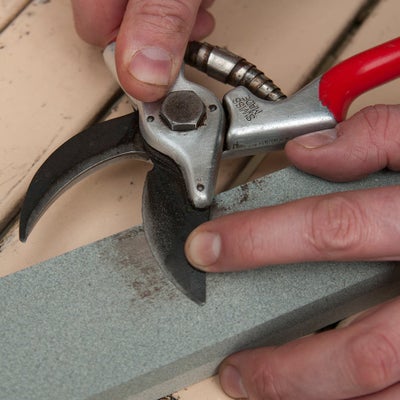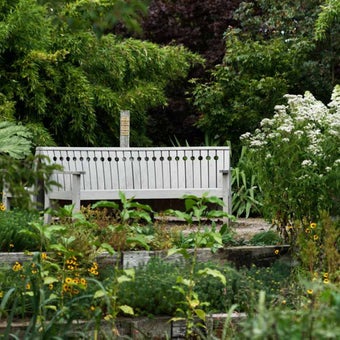
Quick facts
Suitable for - Cultivation and cutting tools
Timing - Anytime
Difficulty - Easy to difficult
Types of sharpening tools
Invest in a sharpening tool suitable for the tools you intend to sharpen. Below are the most common;
Whetstones: these are blocks of fine grained stone; whet is an old word for sharpen. Whetstones are divided into two types depending on whether they need oil or water for lubrication to help the blade glide across the stone. Either type is suitable for sharpening blades like knives and secateurs, just ensure the correct lubrication is used, otherwise the stone will spoil. Some stones are double sided with a coarse and fine grade of grit. Use whetstones on a firm surface such as a kitchen table.
Diamond coated sharpening tools: these come in many shapes and sizes. Diamond-coated blocks or portable pocket-sized tools are ideal for sharpening secateurs and knives on the go. Diamond-coated files are suitable for spades and hoes.
Sharpening steels: these are typically used on kitchen knives. However, gardening versions are available for maintaining garden blades such as loppers.
Files: these make light work of sharpening cultivation tools such as spades and hoes. Select one suitable for working with metal.
Sharpening cultivation tools
Inevitably cultivation tools get blunted and nicked by stones in the soil. Keeping an eye on their condition will help maintain performance.
- Fix the shaft of your hoe or spade in a work bench vice, with the front side facing up
- Begin to work at the nicks with a metal file, pushing it away from you across the blade, keeping at the same angle. Spades tend to be flat so keep the file flat, whereas some hoes may have a slight sloping angle. Work slowly and evenly along the blade. Don’t make the blade too thin as this will affect its strength
- Turn the tool over to remove any burr, (a thin lip of metal that forms on the underside of the blade). Push away from you running the file along the top of the blade until the burr has gone
- Repeat the process again with whetstone if you wish, for a finer finish on the blade
It is generally only necessary to sharpen most cultivation blades once or twice a year, depending on the frequency of use and damage. Some damage may be too severe to correct yourself. Instead go to a tool workshop for a professional tool sharpener.
Sharpening pruning tools
Secateurs and loppers
Secateurs become blunt with use and misuse, making them difficult to use and causing damage when pruning. It is a good idea to have a best pair for pruning and a cheap second pair for jobs like cutting back herbaceous plants.
Check to see if your pair of secateurs can be taken apart for maintenance. Not all can be dismantled. Secateurs can be sharpened with a whetstone, diamond tool or sharpening steel. Here we look at some step-by-steps using a diamond tool. This technique is also suitable for loppers that can be taken apart.
How to sharpen secateurs with a diamond tool
- Loosen and remove the central nut. Carefully disassemble the parts on a piece of kitchen towel or cloth. Spray with WD-40 to soak and loosen dirt.
- Clean your blade before sharpening, to reveal its condition.
- Handheld blade sharpeners generally don’t require oil but could have a coarse and fine side, so start with the coarse side.
- Sharpen the angled side of the blade only. Hold the blade steady and run the diamond tool away from you. Apply even pressure along the blade to expose some new shiny metal, not forgetting the tip. To help with sharpening the blade evenly, mark it with a marker pen, this will be removed as you sharpen and highlight missed sections of blade.
- You can buff along the blade in a circular motion, but do finish with a couple of sweeps to smooth the metal in one direction.
- Check the blade with every sweep. Blunt and damaged blades take longer.
- Use the fine side of the diamond sharpener to give a smooth finish to the blade; 2-3 sweeps should do it.
- Check for a burr on the flat side of the blade. Remove by running the diamond sharpener flat across until it’s removed and smooth to touch. Do not sharpen the flat side of the blade, as this will affect the cutting bite.
- Once clean, reassemble. Put a few drops of general purpose oil or a smear of Vaseline onto the central pivot and spring, to improve movement and reduce stiffness.
- Test sharpness by cutting into a sheet of paper. It should cut cleanly with minimal effort. A blunt pair or secateurs would fold and crush the paper rather than cut.
For loppers and secateurs you can’t take apart, clean the blade as best you can and use the same sharpening motions as above on the open blade. Angle the blade away from you, firmly pushing the sharpening tool. A pocket sized diamond sharpener or sharpening steel is ideal for this and for sharpening on the go, during a large pruning job.
Garden shears
Some garden shears (hedging shears, 'sheep' shears and lawn edging shears) come with a specially-designed sharpener, specific to that brand of shears. Others could be sharpened with general sharpening tools but this is a tricky job if the blades do not come apart or the shears are very blunt. Where this is the case it is usually best to have them professionally sharpened.
Garden knives
There are several types of garden knives, each with their own purpose and differently shaped blade: a general garden knife is a traditional pocket knife; a pruning knife has a curved blade; a knife has a rectangular blade. A general purpose knife will only need sharpening as required. Grafting and propagation knives need to be razor sharp for best results. As with secateurs, garden knives can be sharpened with a whetstone, diamond tool or sharpening steel. Here we look at some step-by-steps using a whetstone.
How to sharpening a garden knife with a whetstone
- Clean the blade with WD-40 before starting.
- Prepare your stone before use. Apply a couple of drops of general purpose oil to the abrasive side of the stone or soak in water for 5-10 minutes, depending on the type of stone. Spread the oil to create a thin film across the stone. Water should sit as a fine film across the stone after soaking.
- Knife blades can have one or two sides to sharpen. Pocket knives usually have one bladed side and one flat, like secateur blades. Pruning knives have two sharpened sides, like a kitchen knife. Check before starting.
- Push the blade up the stone away from you with firm controlled pressure, in one motion keep the blade running along the stone, at the acute angle of the blade.
- Check with every sweep of the stone, looking for newly shiny metal that is smooth, sharp and evenly exposed. Blunt and damaged blades will take longer.
- Prepare the fine side of the stone with oil or water, before finishing the sharp side of the blade with 2-3 sweeps.
- With a double sided blade sharpen both side evenly, to keep the blade balanced.
- On a single sided blade check the flat side for a sharp burr. Remove this by running the flat side of the blade, flat across the stone a couple of times. Do not sharpen this side of the blade as this will affect the cutting impact.
- Test sharpness by holding up a sheet of paper and gently resting the blade on the top edge. The knife should cut through with minimal effort.
- Wipe the blade clean and store somewhere clean and dry.




